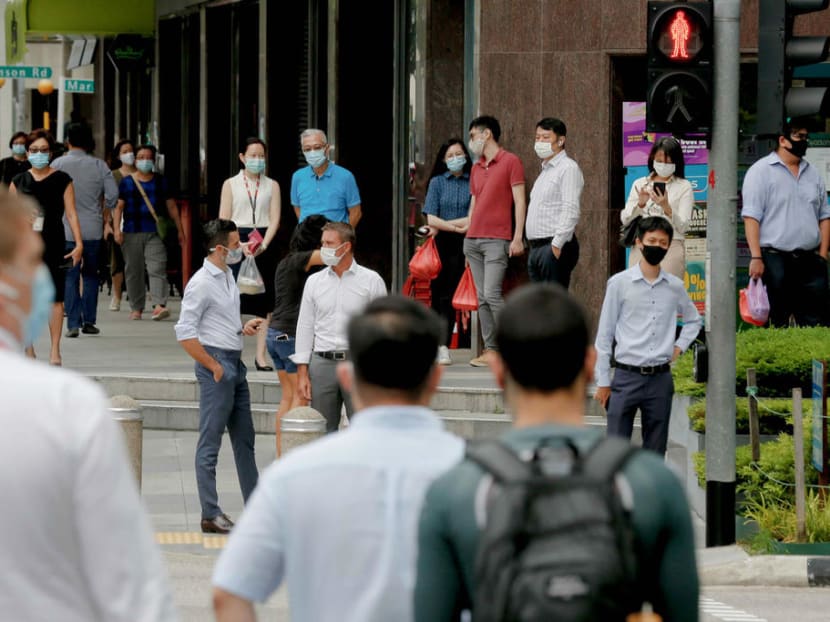Explainer: After the sound and fury, what have we really learnt from Parliament's marathon debate on foreign talent?
SINGAPORE — For 11 hours, parliamentarians on Tuesday (Sept 14) debated over foreign talent policy and job competition, two topics that lay at the heart of many Singaporeans’ anxieties.

The Government is studying how to further improve its immigration framework to have "a finer-grained feel" for foreigners coming here to work.
- The politics of the Sept 14 marathon Parliament debate aside, MPs brought up key facts and economic arguments about the foreign talent issue
- For instance, the official statistics on job growth and wages do not suggest that foreigners are taking jobs from Singaporeans
- The Government is also studying how to further improve its immigration framework to have "a finer-grained feel" for foreigners coming here to work
- The Opposition believes that the education system should do more to produce homegrown talent that industries seek
- However, the PAP Government feels the real issue is population growth
SINGAPORE — For 11 hours, parliamentarians on Tuesday (Sept 14) debated over foreign talent policy and job competition, two topics that lay at the heart of many Singaporeans’ anxieties.
The debate over the two motions filed by Mr Lawrence Wong from the ruling People’s Action Party (PAP) and Non-Constituency Members of Parliament (NCMP) Leong Mun Wai and Hazel Poa of the Progress Singapore Party (PSP) involved 20 MPs, Nominated MPs and NCMPs giving speeches, and was one of the longest in recent parliamentary sittings outside of the annual Budget debates.
Along with a previous debate in July over the merits of Singapore’s free trade agreement with India, the Comprehensive Economic Cooperation Agreement (Ceca), the latest debate has cast much light over the positions and proposals of the various political parties in the House, including the Workers’ Party (WP).
At several points, speeches turned fiery as minister after minister from PAP branded PSP as “racist” and “xenophobic”, firmly rejecting of the racial undertones of PSP’s stances. The labels were repeatedly denied by Mr Leong and Ms Poa.
An offhand remark by Foreign Affairs Minister Vivian Balakrishnan from the ruling party over Mr Leong’s literacy also grabbed headlines on Wednesday, with Dr Balakrishnan apologising afterwards and Mr Leong stating that time can be put to “better use” for Singapore and Singaporeans.
However, to decipher the impact of Singapore’s two-decades-old foreign talent policy and free trade regimes on the jobs and livelihoods of Singaporeans will require diving into the cerebral points of the debate and away from the heat generated during its course.
Rewinding the debate to sieve out the facts, TODAY looks at the key points by the political office-holders, MPs, Nominated MPs and NCMPs to address three important questions on the foreign talent issue as well as the public disquiet over it.
ARE FOREIGNERS TAKING JOBS AWAY FROM SINGAPOREANS?
Calling for higher qualifying salaries for Employment Pass (EP) and S Pass holders, levies and quotas on foreign hires and nationality-based caps, PSP’s two NCMPs contended that PAP’s open-door foreign talent policy has led to the large displacement of Singapore workers.
EPs are issued to foreign professionals who need to earn at least S$4,500 a month and have acceptable qualifications. S Pass holders are mid-level skilled workers who have to earn at least S$2,500 a month.
Giving an example of the finance sector, Mr Leong trotted out figures that showed EP holders occupy 57 per cent of senior positions in the sector and 30 per cent of the domestic retail banking sub-sector that serves Singaporean customers. This is a “far cry” from what it was like before the 1990s, he noted.
“Many Singaporeans believe the work pass holders are here to compete for our jobs. They do not necessarily possess unique skills, let alone create jobs for Singaporeans,” he said, urging for a “rebalancing” of the foreign talent policy.
In response to Mr Leong, several labour statistics were shown to the House by Manpower Minister Tan See Leng, comparing changes from 2010 to 2020.
The number of EP and S Pass holders increased by 110,000 (from 240,000 to 350,000). The number of Singapore professionals, managers, executives and technicians (PMETs) increased by 300,000 in the same period
The number of PMET job vacancies grew from 20,900 in 2010 to 26,000 in 2020, exceeding 30,000 in some years before the pandemic. This includes 4,300 unfilled PMET jobs in the infocomm sector, 4,100 in the finance sector and 2,700 in the professional services sector today
The median wages for resident PMETs, including Central Provident Fund contributions from employers, grew 38 per cent from S$4,600 in 2010 to S$6,300 in 2020, equivalent to a 21 per cent increase after accounting for inflation
Resident PMET unemployment rate hovered below 3 per cent except in the pandemic year of 2020 when it was 3.5 per cent
These are signs that foreign PMETs did not cause rising unemployment among resident PMETs. The rising PMET vacancy rates also do not suggest that every additional foreigner results in one less opportunity for a resident, Dr Tan added.
However, Mr Leong and Ms Poa cast doubt on the statistics regarding the growth of resident PMETs in comparison with EP and S Pass holders, suggesting that the relatively large increase in resident PMETs could be due to a reclassification of foreign work pass holders who take up citizenship.
Giving an example, Ms Poa said that if 1,000 foreigners holding such jobs became permanent residents, they would thus be counted among the resident PMET category.
“There is no increase in jobs, but there is an increase of 1,000 in resident PME jobs and a decrease of 1,000 foreign PME jobs,” she said of her example.
In response, Dr Tan said that the majority of the growth of resident PMETs in the last decade were born-and-bred Singaporeans and that there was no reclassification involved.
THE ‘LUMP OF LABOUR FALLACY’
In his closing remarks, Mr Leong also made reference to the “lump of labour fallacy”, which describes the mistaken assumption that there is only a fixed amount of work available.
PAP may claim that having foreign talent creates jobs, but PSP’s position is that Singapore is only attracting average talent who are not here to create jobs and instead compete with Singaporeans for them, he said.
Professor Hoon Hian Teck, an NMP, said in a response to Mr Leong that the challenge is for people in Singapore to understand that this fallacy does not apply to long-term labour policy.
“The challenge for Singapore... is to recognise that the sources of growth going forward has to come with a continuous integration into the global economy... I think there is great reason to (be) optimistic that the lump of labour fallacy does not apply,” the economics professor at Singapore Management University said to thumps of approval in the House.
Mr Lawrence Wong, who is Finance Minister, said that even if “tens of thousands” of foreigners are taken away, Singaporeans will continue to be displaced because of technology, innovation and the changing nature of work over time.
“In the face of these painful dislocations, it’s easy for politicians to blame someone for them. People don’t lose jobs because of technology or innovations, they say. But it’s because of these foreigners in our midst, they are the reason you have been displaced.
“Far easier to point fingers, make one nationality or another the scapegoat, and blame them all for our troubles, rather than work on reskilling our workers,” Mr Wong said.
Acknowledging that there are downsides to having an open economy, he added that Singapore’s strategy must therefore be to attend to the plight of workers who are displaced.
“But if we want an economy where nobody will ever be displaced, then we will stagnate and atrophy," he continued.
“So the right approach is not to impede progress by holding on to every job even as they become obsolete; but to work hard to protect every worker and help those who are displaced.”
IS SINGAPORE BRINGING THE RIGHT PEOPLE IN?
Mr Wong also said that Singapore brings in manpower and skills from around the world to complement Singaporeans, in order to “give us that extra boost so we can continue to thrive amid intense global competition”.
This is done across the spectrum of the workforce, he added, as he gave an overview of Singapore’s labour policies to regulate the foreigners who work here.
Work permit holders, who are semi-skilled workers from approved source countries employed to work in certain sectors such as the construction and marine industry, are controlled using quotas and levies to regulate the large numbers.
Quotas and levies, along with the need to meet the minimum qualifying salaries of S$2,500 a month currently, are also used to control the inflow of S Pass holders that top up the shortfall of Singaporeans in middle-income jobs.
At the top end of EP holders, salary cut-offs (of S$4,500) are used instead of levies and quotas “because how much the employer is prepared to pay is a practical indicator of quality,” Mr Wong said. These salary restrictions ensure that they have the right skill sets in the areas they are needed most.
The Government is also studying how to further improve this framework “to have a finer-grained feel for the people we bring in, and ensure we get the right talent for Singapore”, he added.
This was a bone of contention for Mr Leong, who said that the minimum qualifying salaries of S$2,500 and S$4,500 a month for S Pass and EP holders respectively were relatively low.
PSP has called for them to be raised to S$4,500 and S$10,000 respectively.
Dr Tan, the Manpower Minister, took issue with PSP’s characterisation of the policies as a “conduit for quick immigration and a source of cheap labour”.
The qualifying salaries are meant to level the playing field for Singaporeans, Dr Tan argued.
He pointed out that the qualifying salaries rise with the age of the applicant, such that the minimum salary for a 40-year-old EP holder is around double of the S$4,500 minimum qualifying salary that applies to the youngest applicants.
KEEPING THE LABOUR MARKET TIGHT
Ms Poa of PSP presented statistics comparing labour force growth to wage growth to show how, in years of larger increases in labour supply, median wages were lower.
This means that increasing labour supply by bringing in migrant workers increases economic growth but dampens local wages, she concluded.
“As we pursue economic growth, we should always bear in mind that economic growth is a means, not an end… to improve the lives of Singaporeans.”
To this, Mr Wong said that although there is some association between tight labour markets and wage growth, one should not draw simplistic policy conclusions from such data.
“If we make a simplistic conclusion, (then if we) just tighten (the labour market) and wages will automatically rise, I think we may be going down a very dangerous path, because beyond a point if wage increases are not matched by productivity increases, we will lose our competitiveness.
“When that happens, we are not just squeezing out foreigners, we will be squeezing out investments and jobs will go with them.”
WHY CAN’T SINGAPOREANS FILL THE SKILLS GAP?
Singapore’s talent policy is thus to maximise the overall talent pool with the aim to achieve the best outcomes for Singaporeans, Mr Wong said.
This includes nurturing homegrown talent “because Singaporeans will always be our priority and at the centre of everything we do”.
To this end, the country is investing significantly in preschool and education to help every child achieve their potential, as well as broadening the concept of merit so that people across different domains can advance and excel at multiple stages of their life, Mr Wong added.
Several WP MPs questioned the ability of Singapore’s education system to address this issue.
Leader of the Opposition Pritam Singh said: “Some ask, 'Why can’t our people do those jobs?' After all, our students score so well on standardised tests. Our much-vaunted education system should have put our workforce in a much better position.”
The Government also needs to track and solve the issue of underemployment, which occurs when workers are not undertaking work for which they are trained, such as an engineer working as a private-hire car driver, Mr Singh said.
His party colleague and fellow Aljunied Group Representation Constituency MP Gerald Giam also noted how the 3,100 places in information and digital technologies undergraduate degree courses last year cannot meet the 20,000 new tech jobs that are in demand each year.
“While it is laudable that so many tech jobs are being created, how much does this benefit Singaporean workers if our people are not equipped with the skills to fill them? It will lead to disappointment both by the companies investing in Singapore and our own people,” Mr Giam said.
THE ISSUE IS ‘THERE ARE JUST NOT ENOUGH OF US’
Addressing this, Mr Wong said that these arguments about providing quality education miss out on the most important issue, which is the “stark reality” that while Singaporeans make a great workforce, “there are just not enough of us”.
“We have (manpower) needs in information technology. We have tremendous needs in engineering. Look at the services sector: Healthcare is growing, we need more people to look after our elderly population. We need more doctors, nurses. We need more physiotherapists. Oh, by the way, low-income issues are a problem, don't we need more social workers, too?” Mr Wong asked.
As for the underemployment question, he said that the Government is already doing its best to train all the mid-career PMETs, highlighting existing efforts in the SkillsFuture movement and the work of the Government’s tripartite partners, which are the unions and employers. However, this does not happen overnight.
“Individuals also have to make the effort in order to make these transitions… It is hard work getting this re-skilling done, and we should not just automatically assume that squeezing foreigners means jobs will go to Singaporeans,” he added.








